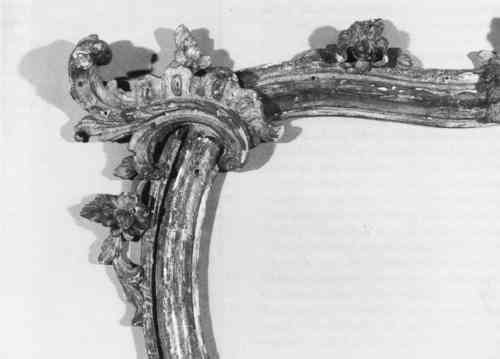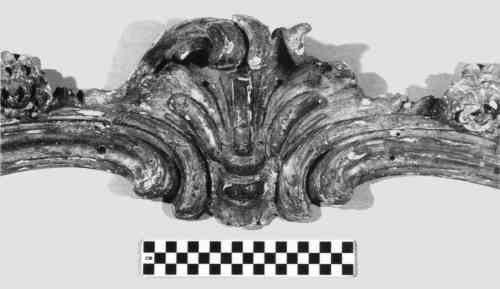CONSERVATION OF THE DARNAULT MIRROR: AN ACRYLIC EMULSION COMPENSATION SYSTEMCYNTHIA MOYER, & GORDON HANLON
3 FIRST TREATMENT PHASESamples were taken from areas of carved wood, gilding, and paint. Sample tangential and radial wood fragments were analyzed microscopically resulting in the identification of the species Tilia spp., or basswood. Fluorescent microscopy was used to help determine the nature of the gesso and grounds: either glue wash or bole, gold leaf, and paint on the moldings and backboard. Fluorescent microscopy also helped to identify the The initial structural condition of the moldings and the gilding on both the main panel and the two parcloses was thoroughly documented with photography (figs. 2, 3) and diagrammatic descriptions in the form of Mylar overlays and hand-colored xeroxes. This documentation showed areas of repair and loss to the wood carvings as well as the patterns of the burnished and matte passages on the gilded surfaces.
To determine the selection of a barrier coat, a test sample was fabricated to simulate aged gesso. The degree to which various percentage viscosities of a dyed synthetic resin, in this case Arkon P-90, would penetrate the surface of this simulated aged gesso layer coated with rabbit skin glue was tested.5 Three sample molding elements from the object were then treated for comparison in the following manner. After initial cleaning of the overpaint and some of the degraded glue size embedded with surface dirt using methylene chloride paint remover, the middle central shell (M), which had minor losses to the gesso and gilt surface, was simply coated with Arkon on any exposed wood. Losses were then filled with a traditional gesso putty. A water-gilding system including traditional bole was used to compensate the burnished areas. Ochre-colored gouache inpainting was used for the matte water-gilded passages to tone out exposed gesso areas, leaving fragmented original gilding exposed. Two other carved sections from the upper frame, the top section (T) and the center right section (CR), which had 60% loss to the gilded surface, were treated differently. After cleaning, they were first completely coated with a 10% rabbit skin glue consolidant, The conservators felt that the initial approach to the final aesthetic of the Darnault mirror, as attempted by the compensation on element M, would have resulted in too many nonreflective matte areas due to the great number of surface losses compensated in gouache. On the other hand, when scrutinizing the surface compensation samples of molding elements T and CR, which were completely overgilded, the conservators found that the barrier coat of Arkon P-90, with its underlying double layer of rabbit skin glue consolidant, proved to be too inflexible to yield the appearance of a burnished gilt surface adjacent to a matte surface. In addition, the multiple coating layers on top of the original surface clogged the recutting in the gesso, obliterating its delicate sculptural quality. This result confirmed one of the original fears about this type of compensation, which includes many additional layers. In comparing the two systems, the conservators sought a compromise between the two sample compensation methods but had not yet come up with a solution by fall 1993. |

